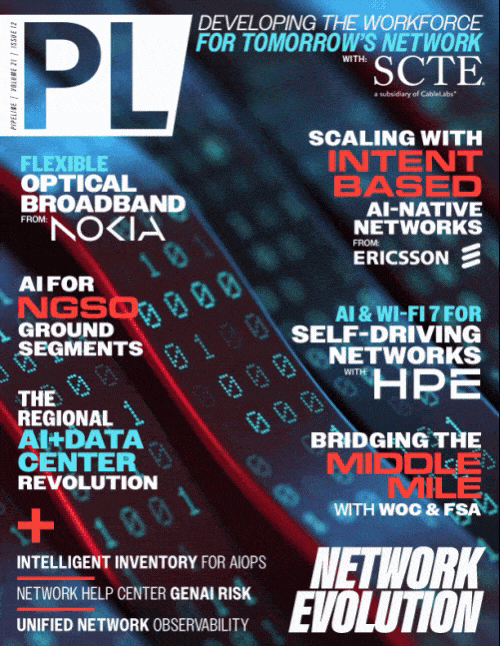The Fast Lane to Self-Driving Networks:
AI Meets Wi-Fi 7 & 6 GHz
Enterprises must have access to “always-on digital experience twins” — AI-native agents that simulate realistic user behavior across the network, even when no users are present.
assurance). On Day 0, zero-touch provisioning and device auto-discovery streamline deployment, while Day 1 automation ensures consistent configuration through global templates and policy-driven
workflows. But the real transformation happens on Day 2 and beyond, where Intent-Based Networking (IBN) comes into play: IT defines the desired outcomes (e.g., performance, security, user
experience), and the network continuously aligns its behavior to meet those goals. This shift from manual control to outcome-driven orchestration is made possible by Explainable AI (X.AI), which
not only automates decisions but also provides transparent reasoning behind them, allowing humans to see not just what the network decided but also why. This clarity builds trust while preserving
oversight — a must for critical environments.
User Experience is the King
In modern enterprises, success is no longer measured by uptime or throughput alone. The true measure is the quality of the end-user experience, shaped by countless variables: device behavior, application performance, RF conditions, switching latency, WAN health, and more. Traditional monitoring tools struggle to correlate these layers in real time and provide a holistic view, often leaving IT teams reactive and overwhelmed. This is where the concept of a Large Experience Model (LEM) becomes essential.An LEM is a specialized AI framework designed to ingest vast amounts of telemetry across the full network stack—wired, wireless, and application—and use that data to model user experience at scale. It doesn’t just detect anomalies; it understands patterns, predicts degradations, and simulates user journeys to validate service quality. By combining machine learning, digital twinning, and X.AI, the LEM enables networks to move from passive infrastructure to proactive, experience-aware systems. In Wi-Fi 7, 6 GHz, and cloud-native environments, where performance demands are high and complexity is deep, the LEM becomes the brain of the self-driving network, orchestrating every decision with the end-user in mind.
Proactive by design: AI and LEM redefining network reliability
Reactive network management is no longer enough. In high-performance digital environments, waiting for users to report issues—or worse, having them suffer silently—creates gaps in visibility and delays in resolution that compromise both productivity and trust. The shift toward proactive network management is not just a technological upgrade; it’s a strategic imperative. Enterprises must have access to “always-on digital experience twins” — AI-native agents that simulate realistic user behavior across the network, even when no users are present. These agents continuously validate connectivity, application reachability, and service health, identifying anomalies before they impact users.Scaling this capability requires a broader intelligence layer, and again, this is where the LEM is central. By aggregating and analyzing billions of telemetry points across devices, applications, and network domains, the LEM enables the infrastructure to understand patterns, predict degradations, and act autonomously. Combined with technologies like unsupervised machine learning, contextual awareness, and XAI, it transforms the network into a self-aware system that ensures reliability becomes proactive rather than reactive. In essence, it creates a network that not only heals itself but also explains its choices, where experience assurance is continuous, intelligent, and deeply user-centric, reinforcing confidence in AI-native operations.
A virtuoso performance:
Self-driving networks unlock the true potential of Wi-Fi 7 and 6 GHz
Imagine a world-class orchestra preparing for a high-stakes performance. At center stage is Wi-Fi 7, the lead singer delivering breathtaking speed, precision, and range. Its voice carries the
melody of ultra-high-bandwidth and ultra-low-latency experiences, captivating the audience with flawless delivery across the 6 GHz spectrum. But behind this star is a finely tuned ensemble working in harmony. IBN is the composer, defining the musical vision of what the performance should achieve and how each section should contribute. XAI is the conductor, guiding every instrument with clarity and purpose, ensuring that decisions are not only made but understood. The LEM acts as the sound engineer, constantly analyzing acoustics, predicting disruptions, and fine-tuning the output to ensure the audience only hears perfection, flaws never reaching their ears. And finally, the self-driving network is the entire stage crew and automation system, working silently in the background to adjust lighting, acoustics, and transitions without human intervention, making the entire performance seamless and adaptive while making the lead singer appear as a true hero!
Together, this orchestra doesn’t just play music; it delivers an experience. And in the digital world, that experience is the one that counts: fast, intelligent, and beautifully orchestrated.



















